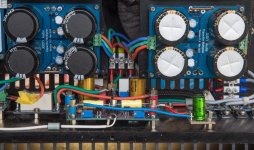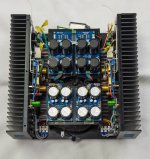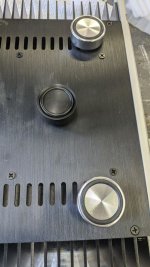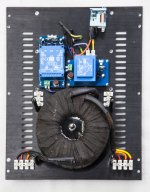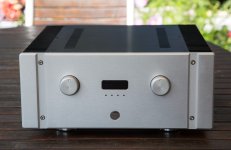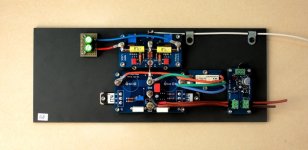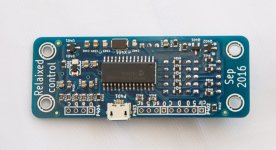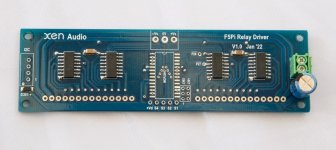It is finally done -- an integrated amplifier using a F5 frontend and the M2OPS.

🙂
Patrick
🙂
Patrick
Attachments
Last edited:
More pictures of the finished amp will follow when the weather gets better.
Patrick
Patrick
The References
1. https://www.diyaudio.com/community/...in-class-a-b-and-maybe-a-power-whammy.390636/
2. https://www.diyaudio.com/community/threads/complementary-power-mosfets.378024/
3. https://www.diyaudio.com/community/threads/f5-headamp.271926/
4. https://www.diyaudio.com/community/threads/the-f5x-preamp.225230/
5. https://www.diyaudio.com/community/threads/f5-headamp.271926/post-4282959
6. https://www.diyaudio.com/community/...orch-preamplifier-part-ii.146693/post-5304360
7. https://www.diyaudio.com/community/...orch-preamplifier-part-ii.146693/post-5304493
8. https://www.diyaudio.com/community/...-relay-resistor-logarithmic-attenuator.21198/
9. https://en.wikipedia.org/wiki/Logarithmic_resistor_ladder
10. http://www.vaneijndhoven.net/jos/relaixedpassive/index.html
11. http://www.eijndhoven.net/jos/switchr/index.html
12. https://components.omron.com/us-en/faq/relays/20211027-42
13. https://www.findernet.com/en/uk/news/relay-contact-materials-does-it-matter/
14.

15. https://www.ti.com/product/CD40192B
16. https://sourceforge.net/p/relaixed2/code/HEAD/tree/
Patrick
1. https://www.diyaudio.com/community/...in-class-a-b-and-maybe-a-power-whammy.390636/
2. https://www.diyaudio.com/community/threads/complementary-power-mosfets.378024/
3. https://www.diyaudio.com/community/threads/f5-headamp.271926/
4. https://www.diyaudio.com/community/threads/the-f5x-preamp.225230/
5. https://www.diyaudio.com/community/threads/f5-headamp.271926/post-4282959
6. https://www.diyaudio.com/community/...orch-preamplifier-part-ii.146693/post-5304360
7. https://www.diyaudio.com/community/...orch-preamplifier-part-ii.146693/post-5304493
8. https://www.diyaudio.com/community/...-relay-resistor-logarithmic-attenuator.21198/
9. https://en.wikipedia.org/wiki/Logarithmic_resistor_ladder
10. http://www.vaneijndhoven.net/jos/relaixedpassive/index.html
11. http://www.eijndhoven.net/jos/switchr/index.html
12. https://components.omron.com/us-en/faq/relays/20211027-42
13. https://www.findernet.com/en/uk/news/relay-contact-materials-does-it-matter/
14.
15. https://www.ti.com/product/CD40192B
16. https://sourceforge.net/p/relaixed2/code/HEAD/tree/
Patrick
A lot of the credit goes to the Alpha tester, who does most of the building.
I was told that he was very happy with the sound.
But I'll let him tell you the details when he has more time.
Also most sincere thanks to Jan Didden for helping with the many rounds of distortion measurements.
Patrick
I was told that he was very happy with the sound.
But I'll let him tell you the details when he has more time.
Also most sincere thanks to Jan Didden for helping with the many rounds of distortion measurements.
Patrick
The Alpha tester is not a xen Team member.
He is a good friend and an experienced DIY'er.
I want to have someone whom I trust can execute the build to a high standard.
But who is still independent, so that he is completely free to post any comments or listening impressions, positive and negative.
The audition was also done with other DIY friends nearby him, and compared with other DIY amps.
So hopefully it should be as "objective" as it can be.
But give him time.
Was already a stressful weekend for him to get it finished. 🤓
Patrick
He is a good friend and an experienced DIY'er.
I want to have someone whom I trust can execute the build to a high standard.
But who is still independent, so that he is completely free to post any comments or listening impressions, positive and negative.
The audition was also done with other DIY friends nearby him, and compared with other DIY amps.
So hopefully it should be as "objective" as it can be.
But give him time.
Was already a stressful weekend for him to get it finished. 🤓
Patrick
Last edited:
Amazing result as always Patrick and congratulations to the Alpha tester as well! Well done!
It's quite clear that a massive amount of work and prep went into this and I'm sure we only see the path taken and not all the effort that went into the abandoned trials along the way.
Looking forward to the listening impressions from the tester and his lucky friends 🙂
Cheers,
Stephen
It's quite clear that a massive amount of work and prep went into this and I'm sure we only see the path taken and not all the effort that went into the abandoned trials along the way.
Looking forward to the listening impressions from the tester and his lucky friends 🙂
Cheers,
Stephen
I notice that the first sounds from the amp appear to have come while the volume was set to 42. Nice.
Otherwise, a really nice build and design. Time, patience, experience and a determination to 'do it right'.
Well done to all concerned.
Otherwise, a really nice build and design. Time, patience, experience and a determination to 'do it right'.
Well done to all concerned.
Exposing my obvious ignorance here...
For confirmation; U1 is the heart of the unity gain power buffer which is used to stabiize the load for the front end? what are Ro1 and Ro2?
For confirmation; U1 is the heart of the unity gain power buffer which is used to stabiize the load for the front end? what are Ro1 and Ro2?
First sound was music from a smartphone and therefore the level is lower than your normal music source.
The right side of the schematics (including U1, Ro1,2, etc.) is the DC Servo.
It is not used as it proves to be unnecessary.
See the Measurement Section of the article.
Patrick
The right side of the schematics (including U1, Ro1,2, etc.) is the DC Servo.
It is not used as it proves to be unnecessary.
See the Measurement Section of the article.
Patrick
Not to forget of course the work you did for us (all) on the MOSFET comparison of the M2OPS.It's quite clear that a massive amount of work and prep went into this and I'm sure we only see the path taken and not all the effort that went into the abandoned trials along the way.
https://www.diyaudio.com/community/threads/complementary-power-mosfets.378024/page-2#post-6889027
🙏🙏
Patrick
To answer a couple of questions :
The prototype was build using all Toshiba devices, i.e. K170/J74, K2013/J313, and K3497/J618.
The first two pairs are standard on Pass Labs products and many DIY projects.
Some says that it is another project using unobtainiums.
But if you look around, components for analogue, especially for audio, are disappearing day by day.
That is now not only limited to transistors, but also to other devices, both active and passive.
All the Nichicon Audio Capacitors are End of Life.
There are essentially next to no low-noise JFETs in production except for switching.
So in a few years, either you can only use Class D chips, or buy NOS devices while they are still available.
Stock up while you can, unless of course you are happy to build with ICs, whether analogue chipamps or Class D.
Bear in mind that a Class A Power Amp Heatsink Enclosure will easily set you back 300€.
An audio grade toroidal transformer another 100€.
How much do you think should be spent on the sonic-defining active devices ?
But for those who have a limited budget and still want to join the fun, the circuit is flexible enough to accommodate alternative devices.
It will at the expense of some additional distortion.
Here are some alternative configurations :
Input JFETs
2SK246BL / 2SJ103BL, as in Jean-Marc Planeteve’s Zenquito, with some resistor value changes
2N5457 / 5460 and their SMD version, obsolete but still can be found, resistor value changes
TO220 MOSFETs
FQP3N30 / 3P20, obsolete but available at Rochester, requires 5V extra for front end PSU.
IRF610 / 9610, also requires 5V extra for front end PS.
Output MOSFETs
IRFP240 / 9240, results in earlier clipping due to higher Vgs at bias.
Patrick
The prototype was build using all Toshiba devices, i.e. K170/J74, K2013/J313, and K3497/J618.
The first two pairs are standard on Pass Labs products and many DIY projects.
Some says that it is another project using unobtainiums.
But if you look around, components for analogue, especially for audio, are disappearing day by day.
That is now not only limited to transistors, but also to other devices, both active and passive.
All the Nichicon Audio Capacitors are End of Life.
There are essentially next to no low-noise JFETs in production except for switching.
So in a few years, either you can only use Class D chips, or buy NOS devices while they are still available.
Stock up while you can, unless of course you are happy to build with ICs, whether analogue chipamps or Class D.
Bear in mind that a Class A Power Amp Heatsink Enclosure will easily set you back 300€.
An audio grade toroidal transformer another 100€.
How much do you think should be spent on the sonic-defining active devices ?
But for those who have a limited budget and still want to join the fun, the circuit is flexible enough to accommodate alternative devices.
It will at the expense of some additional distortion.
Here are some alternative configurations :
Input JFETs
2SK246BL / 2SJ103BL, as in Jean-Marc Planeteve’s Zenquito, with some resistor value changes
2N5457 / 5460 and their SMD version, obsolete but still can be found, resistor value changes
TO220 MOSFETs
FQP3N30 / 3P20, obsolete but available at Rochester, requires 5V extra for front end PSU.
IRF610 / 9610, also requires 5V extra for front end PS.
Output MOSFETs
IRFP240 / 9240, results in earlier clipping due to higher Vgs at bias.
Patrick
This is really a fantastic project. Congratulations to all builders and testers. The construction has been thought through down to the smallest detail and looks superb. I am very impressed by the measurement results.
My monoblock is already impatiently waiting for new components. I think it is ideal for two stereo channels and will not have to feel abused.
But I would only build it as an integrated amplifier F5P frontend + M2OPS powerful stage and PS.
Is it planned to make the PCBs of F5P + M2OPS available here?
That would be a really lovely Christmas cookies
My monoblock is already impatiently waiting for new components. I think it is ideal for two stereo channels and will not have to feel abused.
But I would only build it as an integrated amplifier F5P frontend + M2OPS powerful stage and PS.
Is it planned to make the PCBs of F5P + M2OPS available here?
That would be a really lovely Christmas cookies

We shall make everything you cannot get easily available, including complete Q-Sets.
But please wait till the Alpha Tester has a chance to tell his story first.
🙂
Patrick
But please wait till the Alpha Tester has a chance to tell his story first.
🙂
Patrick
- Home
- Amplifiers
- Pass Labs
- The F5Pi -- F5P Voltage Gain Stage + M2 Output Stage = Perfectly Integrated
